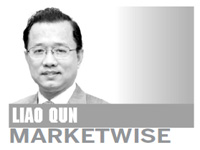China enters into a monetary tightening cycle
Updated: 2010-12-01 07:10
(HK Edition)
|
|||||||||

China's monetary policy ceremoniously entered into a tightening cycle in October 2010. The latest tightening move is the 0.5 percent hike in the reserve requirement ratio (RRR) for banks, which was announced by the People's Bank of China on November 19 - the fifth such hike this year and the second in just nine days.
Last year, in an effort to counteract the impact of the global financial tsunami, China followed the footsteps of many countries by adopting a very loose monetary policy.
Now, with the strong recovery of the domestic economy as well as that of many other countries, the country's monetary policy stance has swung gradually from "very loose" to "appropriately loose", as the Central Government raised the RRR in January, February and May.
Since October, in the face of rising inflation and the threat of hot money inflows expected from the US monetary QE2 (second round of quantitative easing) policy, China's stance has shifted further to "appropriately tight". Interest rates were raised on October 11, followed by two hikes in the RRR on November 11 and 19 respectively, marking the beginning of a new monetary tightening cycle.
Currently, the RRR stands at 18 percent for large banks and 14.5 percent for medium and small sized banks, both at their highest levels since 1985 when the ratios were normalized.
Given that the total deposit balance in the country's banking system stood at 70 trillion yuan at end-October 2010, a rise of 0.5 percent in the RRR is expected to lock up about 350 billion yuan in market liquidity, assuming no extra reserves are held by banks. It would mean that the 1 percent total increase in the ratio over the nine days to November 19 might have reduced market liquidity by about 700 billion yuan.
Some would ask then whether the current RRR levels represent a ceiling for the ratio. The answer is no. In fact, no such ceiling exists, and the ratio can be raised anytime when market liquidity is overly affluent. Indeed, the ratio is an effective monetary tool to directly absorb market liquidity.
Meanwhile, the benchmark interest rate - that is, the one-year lending rate - is currently at 5.56 percent. Indeed, it is much higher than in developed economies. However, it can hardly be regarded as high for an emerging market economy such as China, which is growing at a rate of around 10 percent per year. Indeed, compared with historical interest rate levels in China, it is at the low end of the spectrum.
That is to say, there is still a lot of room for further increases in interest rates and the RRR.
More importantly, economic and financial market fundamentals call for continued monetary tightening. On the economic front, growth has stabilized following a slowdown in the second quarter of this year. On the inflation front, rising prices have become a major risk for the country in recent months, as a joint result of excess liquidity, surging grain prices, and buoyant commodity prices in international markets. CPI rose by 3.5 percent year-on-year in the third quarter and 4.4 percent in October, as compared to 2.6 percent in the first half.
A greater threat lies ahead, however - the expected acceleration of hot money inflows resulting from QE2 are set to push up asset prices and add further pressure to consumer prices in the coming months.
It is worth noting that both the domestic and global economic and financial landscapes are changing more rapidly than ever, which may lead to new policy moves happening more frequently than before. They will also be put into place quickly whenever economic conditions warrant.
So what and when will the next move be? It is apparent that the next move could well be an interest rate hike, given two successive rises in the RRR recently. And there are two likely scenarios for the next rate hike move. One is if the November CPI figures - expected to be available around December 10 - turns out to be higher than - or at least close to - October's 4.4 percent rate. The other is if the real impact of QE2 on China - the flow of hot money into the country - turns out to be stronger than currently thought.
Given that price figures for the first half of November were not optimistic and QE2 has just begun, the next tightening move by the Central Government is likely to take place by the end of this year.
The author is senior vice president, and chief economist and strategist of China banking for CITIC Bank International Ltd. The opinions expressed here are entirely his own.
(HK Edition 12/01/2010 page2)